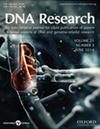传粉榕蜂的染色体水平基因组组装。
IF 3.9
2区 生物学
Q1 GENETICS & HEREDITY
引用次数: 2
摘要
榕小蜂一直被认为是其寄主榕科(Moraceae, Ficus)的物种特异性传粉者,并与其寄主构成了研究共同进化和共同物种形成的模式系统。高质量基因组的可用性将有助于进一步揭示这些特征背后的机制。在这里,我们提出了一个高质量的染色体水平基因组的Valisa javana由PacBio长读和Illumina短读的组合开发。从13个contigs中组装得到的基因组大小为296.34 Mb, contig N50长度为26.76 kb。比较基因组分析揭示了扩展的和正向选择的与生物学特征相关的基因,这些基因有助于无花果黄蜂在其高度特异性寄主的合囊中生活。鉴定了与化学感觉、解毒和毒液基因相关的蛋白质编码基因。在爪哇水鸡嗅觉信号转导通路中,经气味刺激的样本与对照的转录组数据中发现了一些差异表达基因,如嗅觉转导、cAMP、cGMP-PKG、钙、Ras和Rap1。该研究为无花果黄蜂提供了宝贵的基因组资源,并进一步揭示了它们在不同地方对宿主的适应特征以及与宿主共种的机制。本文章由计算机程序翻译,如有差异,请以英文原文为准。
A chromosome-level genome assembly of the pollinating fig wasp Valisia javana.
Fig wasp has always been thought the species-specific pollinator for their host fig (Moraceae, Ficus) and constitute a model system with its host to study co-evolution and co-speciation. The availability of a high-quality genome will help to further reveal the mechanisms underlying these characteristics. Here, we present a high-quality chromosome-level genome for Valisa javana developed by a combination of PacBio long-read and Illumina short-read. The assembled genome size is 296.34 Mb from 13 contigs with a contig N50 length of 26.76 kb. Comparative genomic analysis revealed expanded and positively selected genes related to biological features that aid fig wasps living in syconium of its highly specific host. Protein-coding genes associated with chemosensory, detoxification and venom genes were identified. Several differentially expressed genes in transcriptome data of V. javana between odor-stimulated samples and the controls have been identified in some olfactory signal transduction pathways, e.g. olfactory transduction, cAMP, cGMP-PKG, Calcim, Ras and Rap1. This study provides a valuable genomic resource for a fig wasp, and sheds insight into further revealing the mechanisms underlying their adaptive traits to their hosts in different places and co-speciation with their host.
求助全文
通过发布文献求助,成功后即可免费获取论文全文。
去求助
来源期刊

DNA Research
生物-遗传学
CiteScore
6.00
自引率
4.90%
发文量
39
审稿时长
4.5 months
期刊介绍:
DNA Research is an internationally peer-reviewed journal which aims at publishing papers of highest quality in broad aspects of DNA and genome-related research. Emphasis will be made on the following subjects: 1) Sequencing and characterization of genomes/important genomic regions, 2) Comprehensive analysis of the functions of genes, gene families and genomes, 3) Techniques and equipments useful for structural and functional analysis of genes, gene families and genomes, 4) Computer algorithms and/or their applications relevant to structural and functional analysis of genes and genomes. The journal also welcomes novel findings in other scientific disciplines related to genomes.
 求助内容:
求助内容: 应助结果提醒方式:
应助结果提醒方式:


